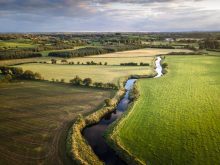Researchers find that 37 of 46 species showed greater declines or less responsive increases due to rising temperatures
Recent research from Simon Fraser University in Burnaby, B.C., suggests that the greatest negative influence bumblebees face from climate change are changes in temperature, which could affect the insects even more than precipitation changes or changes in the flower types.
The study focused on the historical changes driven by climate change and rising temperatures over the past 120 years influencing where bee species have been found across North America.
“We did not look at the effect of temperature on the effectiveness of pollination itself, we only looked at changes in where species are found through time,” said Hanna Jackson, study leader and a master’s student in the university’s Department of Biological Sciences.
Read Also

Short rapeseed crop may put China in a bind
Industry thinks China’s rapeseed crop is way smaller than the official government estimate. The country’s canola imports will also be down, so there will be a lot of unmet demand.
In exploring the impacts of changing temperature, precipitation and floral resources on bumblebee site occupancies, the research team addressed two key questions.
According to the report, the first question was whether there was evidence for genus-wide declines in bumblebee site occupancy across North America over the past 120 years and, if so, to what extent were those trends specifically characterized by individual species.
The second question was whether those species-specific changes in site occupancy were linked to the influences of climate change.
The researchers amassed historical datasets from a variety of sources including museum records, scientific surveys, and citizen science records.
Specimen collections of charismatic species like bumblebees, butterflies and birds were common long before it was so common to do specific scientific research on them. In the process of amassing data, the researchers conducted considerable filtering to ensure the reliability and accuracy of the data to obtain high-quality results. The final dataset contained records on 46 bumblebee species from 1900 to 2020.
Researchers created two occupancy models, one focused on time and the other on environmental factors. In the model focused on time, it asked whether species occupancy had increased, decreased, or remained constant over the past 120 years. The other model, which focused on environmental factors, looked at temperature, precipitation, and flower sources as predictors of occupancy to find out how occupancy is related to all three variables.
When estimating the effects of climate and land-use variables on species’ occupancy, researchers found that six bumblebee species decreased through time, 22 increased and the remaining 18 remained stable. However, Jackson wrote in the report that it was the influence of rising temperature over time that had the most negative impact with 37 of the 46 species showing greater declines or less responsive increases in occupancy compared to the temperature remaining constant.
“While we found that most species’ occupancy probability was stable or increasing in occupancy, we think it’s important to note that this is not the same as an increase in the number of bumblebees that there are,” said Jackson. “Our metric looks at changes in where they’re found, not how many are found there. For example, if species are expanding their ranges northwards trying to escape increasing temperatures, you might expect that to show up as increasing occupancy probability because that species is now found in more places. You can see that it makes interpretation of these trends difficult. On the other hand, the finding that species occupancy was lower than it would have been had temperatures not changed is much clearer.”
She wrote that nine species of bumblebee exhibited declines that link to changing temperatures within their ranges, but the team did not find patterns in the other factors that were studied such as precipitation and only one species declined based on floral resources. Recognizing the importance of bumble bees as pollinators for both wild plants and food crops, Jackson stressed the need to develop conservation strategies to account for future impacts of climate change on bee populations.
“Our study specifically shows that preventing the progression of climate change, specifically changes in temperature, would be a major help to the bumblebees of North America,” she said. “More broadly than just results from our study, people can help by planting gardens with native flowers that bumblebees rely on for food. Specifically, they need plants to flower throughout the spring and summer months, so planting a garden with plants that flower at different times is a wonderful way to help out the pollinators that live in your area.
“Another way that people can help is by getting involved with community science projects. One easy example is the app iNaturalist where people can take pictures of species they find, and scientists can identify them and then use these records in their research.”
Plants frequented by bees include thrift, rose, foxglove, black-eyed susan and bluebeard and crops such as tomatoes and all berries.
As the climate changes, Jackson said the composition of the bumblebee community will likely continue to change, with most species’ ranges shrinking and few species increasing. She expects that future research work will need to look at other variables impacting bumblebees.
“Future work should examine the effects of other variables on bumblebees such as pesticide use and habitat availability but, additionally, focal studies of single species at local scales should be prioritized to validate our much broader, large-scale results.”
The research, “Climate change winners and losers among North American bumblebees,” was published in Biology Letters, The Royal Society.















